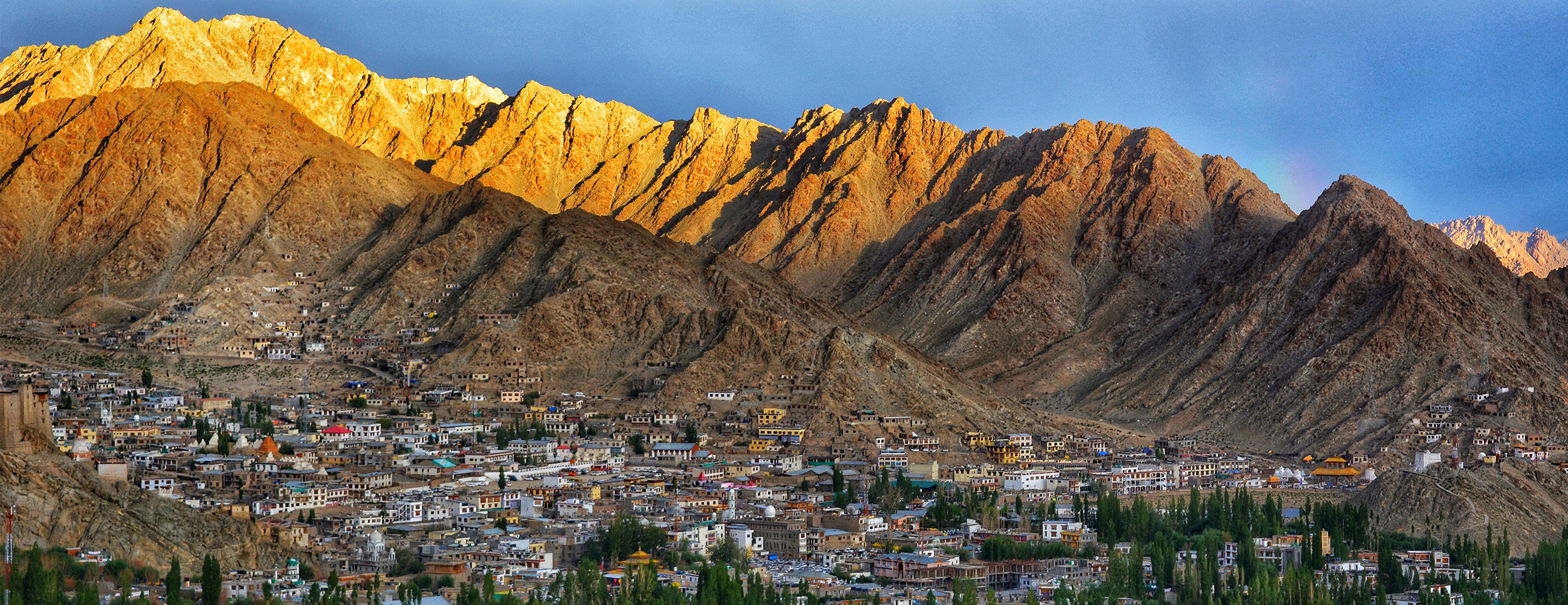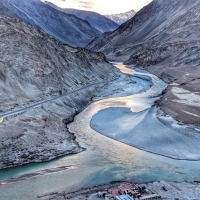Enquire Now

When you go to Ladakh, you don’t get stories; you get CHRONICLES! Leh-Ladakh is the best inspiration for a poet, painter, and photographer. As the altitude increases, the scenery on the way to Ladakh changes like scenes from a movie.
Ladakh is a natural wonder because of the vast Himalayan Mountains, clean glaciers, and beautiful valleys. A fun trip to Ladakh via the world’s highest passes gives you an adrenaline rush and some of the most beautiful views you can imagine.
One essential thing is the place’s culture and people. One of the friendliest clans in the world lives in Ladakh. Their culture is full of color and peace, making you immediately fall in love with them. We recommend that you enjoy Ladakhi food while you’re here because you won’t be able to find it anywhere in the World.
A trip to Leh is the ultimate adventure. You can watch people defy gravitational effects at the Magnetic Hill, speed through the dangerous Gata Loops, or ride through the KhardungLa Pass. Bike riding has always been popular in Ladakh, but there’s something else to add to the list! It is to take a photo of the famous “Yellow Scooter” at the beautiful Pangong Lake.
About Leh- Ladakh:
Folks of Indo-Aryan & Tibetan descent live in Ladakh, which is in the debatable Jammu and Kashmir. It lies in the Kunlun Mountains chain just above Himalayan. This is one of Kashmir’s areas with the fewest people.
The area includes the Indus Valley, the Baltistan (Baltiyul) valleys, Lahaul, the remote Zanskar and Spiti towards the south, Ngari, along with the Rudok region and Guge, toward the east, and the Nubra valleys towards the north, atop gray Khardung La with in Ladakh mountain range. The divide between the Ladakh and the Tibetan Plateau starts near Pulu, goes south along the ridges east of Rudok, where Aling Kangri & Mavang Kangri are located, and ends near Mayum La.
Ladakh is known for the beauty & culture of its remote mountains. It is frequently called “Little Tibet” because its culture is very similar to Tibet’s. In history, Ladakh’s important location at the intersection of trade routes gave it a lot of importance. However, global commerce has decreased since the neighboring Chinese government closed its borders to Tibet & Central Asia in the 1960s. The GoI has been trying to get more tourists to visit Ladakh since 1974, even though it is still a disputed area between India and Pakistan.
Leh is Ladakh’s biggest town. Most Ladakhis are Buddhists of Tibet, while most of the rest are Shia Muslims. In recent years, Ladakhis have asked for Ladakh to be made a union territory due to its religious and cultural disparities with predominantly Muslim Kashmir.
Why is Leh so important and so beautiful?
Ladakh used to make the most of its location at the intersection of some of Asia’s most important trade routes. Ladakhis collected taxes on goods from Turkestan, Punjab, Tibet, Kashmir, and Baltistan and went through their kingdom. A small number of Ladakhis also worked as vendors and caravan traders. They helped move textiles, carpets, dyestuffs, and drugs from Punjab to Xinjiang. But this global trade has completely stopped since the Chinese government shut down the borders with Tibet & Central Asia.
Since 1974, the Indian government has been trying to get people to go trekking and do other tourism activities in Ladakh instead of the troubled area of Kashmir. Food subsidies, government jobs, the tourism sector, and infrastructure improvements have made it easier for many people to move from the farms to Leh town.
About the Tour:
Get set to make one desire to go on a road trip in Ladakh come true, where you’ll experience a mix of thrills, peace, enticing beauty, and the culture of the “Land of High Passes.” A beautiful drive via Leh-Ladakh, a land with snow-capped mountain ranges and the highest motorable passes, gives the impression that you’re on the world’s edge. Ladakh is unique because it has mountain ranges, forests, deserts, ponds, rivers, waterfalls, and more, all in one gorgeous and changing landscape.
Quick Info:
Inclusions:
Things Not to Miss:
Know Before You Go for Exciting Leh Ladakh Tour with Pangong Lake:
Medication:

Meals

Meals

Sedan-Car

Meals

Meals

Meals

Meals

Meals

Meals

Manali – Leh – Manali Package
9D 8NStarting from INR. 40000
INR. 31999 20% Off
Per AdultWe at Trippy Adventures believe in providing a hassle-free travel experience to our customers! We try to make our booking process easy and secure for you so that you can rest easy and concentrate on packing and dreaming about the experiences!

Book A Tour
Browse through our list of tours and select your preferred one!

Payment Process
Pay through our secure payment gateway for the trip of your choice.

Confirmation
Receive immediate confirmation on the registered mail id.

Enjoy Your Trip
Rest easy knowing you booked with us and have an unforgettable experience for a lifetime.
A one-week trip to Leh for one person usually costs around Rs18k. So, a one-week trip to Leh for two persons costs about Rs36k. In Leh, it costs Rs72k for two people to travel for two weeks.
First, if you want to go to Ladakh, you must obtain a permit. It is a required pass, and you won't be able to go to most places in Ladakh without it. This document is called an "Inner Line Permit," You can get it either in person at the SDM workplace in Leh City or through a website.
April to June are among the best times to visit Leh. When the sun is out, it shines brightly and retains the day warm.
On the Srinagar-Leh Highway or the Manali-Leh Highway, you can rent a car and drive it yourself to get to Leh. But people who rent cars outside of Leh Ladakh and drive them themselves are not allowed to go sightseeing in Ladakh. This means they can't go to places such as Nubra Valley, Pangong Tso, and Tso Moriri.
Tourist Attractions on the Highway Between Manali and Leh: Deepak Taal. Rohtang La. Jispa. Shaheed Sainik Bhawan. Baralacha La. Suraj Taal. Gata Loops.
The world's highest road is now at Umling La Pass, which is in eastern Ladakh and is 19,300 feet above the sea. On Tuesday, Union defense minister Rajnath Singh opened critical infrastructure initiatives in India's border regions. These projects will improve the country's strategic capabilities.